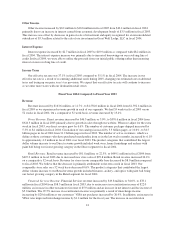Cabela's 2005 Annual Report Download - page 58
Download and view the complete annual report
Please find page 58 of the 2005 Cabela's annual report below. You can navigate through the pages in the report by either clicking on the pages listed below, or by using the keyword search tool below to find specific information within the annual report.
Charge-offs
Gross charge-offs reflect the uncollectible principal, interest and fees on a customer’s account. Recoveries
reflect the amounts collected on previously charged-off accounts. Most bankcard issuers charge off accounts at
180 days. We charge off accounts on the 24th day of the month after an account becomes 115 days contractually
delinquent, except in the case of cardholder bankruptcies and cardholder deaths. Cardholder bankruptcies are
charged off 30 days after notification, and delinquencies caused by cardholder deaths are charged off on the 24th
day of the month after an account is 60 days contractually delinquent. As a result, our charge-off rates are not
directly comparable to other participants in the bankcard industry. On October 17, 2005, the Bankruptcy Reform
Act was enacted, which makes it more difficult to file bankruptcy and have certain debts forgiven. We
experienced an increase in the number of cardholders filing for bankruptcy before the October 17th deadline. This
was included in our provision for bad debts in fiscal year 2005. Our charge-off activity for the managed portfolio
for fiscal years 2005, 2004 and 2003 is summarized below:
Fiscal Year
2005 2004 2003
Gross charge-offs ........................................ $27,829 $23,134 $19,554
Recoveries ............................................. 4,228 3,477 2,499
Net charge-offs .......................................... 23,602 19,658 17,055
Net charge-offs as a percentage of average managed loans ........ 2.15% 2.21% 2.42%
Liquidity and Capital Resources
Overview
Our merchandising business and our Financial Services segment have significantly different liquidity and
capital needs. The primary cash requirements of our merchandising business relate to capital for new destination
retail stores, purchases of economic development bonds related to the development of new destination retail
stores, purchase of inventory, investments in our management information systems and other infrastructure, and
other general working capital needs. We historically have met these requirements by generating cash from our
merchandising business operations, borrowing under revolving credit facilities, issuing debt and equity securities,
obtaining economic development grants from state and local governments in connection with developing our
destination retail stores, collecting principal and interest payments on our economic development bonds and from
the retirement of economic development bonds. The cash flow we generate from our merchandising business is
seasonal, with our peak cash requirements for inventory occurring between May and November. While we have
consistently generated overall positive annual cash flow from our operating activities, other sources of liquidity
are generally required by our merchandising business during these peak cash use periods. These sources
historically have included short-term borrowings under our revolving credit facility and access to debt markets,
such as the private placement of long-term debt securities we completed in September 2002. While we generally
have been able to manage our cash needs during peak periods, if any disruption occurred to our funding sources,
or if we underestimated our cash needs, we would be unable to purchase inventory and otherwise conduct our
merchandising business to its maximum effectiveness, which would result in reduced revenue and profits.
The primary cash requirements of our Financial Services segment relate to the generation of credit card
loans and the purchase of points used in the customer loyalty rewards program from our merchandising business.
The bank obtains funds for these purposes through various financing activities, which include engaging in
securitization transactions, borrowing under federal funds bank credit facilities, selling certificates of deposit and
generating cash from operations. Our bank’s charter is limited to issuing credit cards and selling brokered
certificates of deposit of $100,000 or more, and it does not accept demand deposits or make non-credit card
loans. Consequently, our bank cannot lend money to Cabela’s Incorporated or our other affiliates. The bank is
subject to capital requirements imposed by Nebraska banking law and the VISA membership rules, and its ability
to pay dividends is limited by Nebraska and federal banking law.
46
























